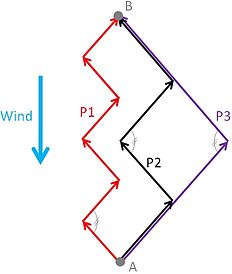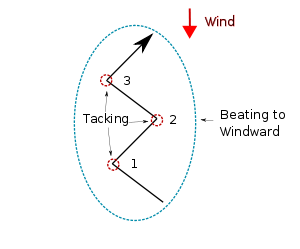- Tacking (sailing)
-
Tacking or coming about is a sailing maneuver by which a sailing vessel (which is sailing approximately into the wind) turns its bow through the wind so that the direction from which the wind blows changes from one side to the other. For example, if a vessel is sailing on a starboard tack with the wind blowing from the right side and tacks, it will end up on a port tack with the wind blowing from the left side. See the image at the right; the red arrow indicates the wind direction. This maneuver is frequently used when the desired direction is (nearly) directly into the wind.
In practice, the sails are set at an angle of 45° to the wind for conventional sailships and the tacking course is kept as short as possible before a new tack is set in. Rotor ships can tack much closer to the wind, 20 to 30°.
A similar maneuver (termed jibing) is used when sailing before the wind.
Contents
Technical usage
Tacking is distinct from jibing, where the ship's stern passes through the wind.
Tacking is sometimes confused with beating to windward, which is a process of beating a course upwind and generally implies (but does not require) actually coming about. In the accompanying figure, the boat is seen to tack three times while beating to windward.
When used without a modifier, the term "tacking" is always synonymous with "coming about"; however, some find it acceptable to say "tack downwind"; i.e., change tack by jibing rather than coming about. Racers often use this maneuver because most modern sailboats (especially larger boats with spinnakers and a variety of staysails) sail substantially faster on a broad reach than when running "dead" downwind. The extra speed gained by zigzagging downwind can more than make up for the extra distance that must be covered. Cruising boats also often tack downwind when the swells are also coming from dead astern (i.e., there is a "following sea"), because of the more stable motion of the hull.
Beating
 Depending on the situation, different intervals between tacking can be used. This does not influence the total distance travelled (though may impact the time required). Sailing from point A to point B, path P1 involves more turns but only requires a narrow channel. Path P2 involves fewer turns but a wider channel. Path P3 requires only a single turn but covers comparatively the widest channel.
Depending on the situation, different intervals between tacking can be used. This does not influence the total distance travelled (though may impact the time required). Sailing from point A to point B, path P1 involves more turns but only requires a narrow channel. Path P2 involves fewer turns but a wider channel. Path P3 requires only a single turn but covers comparatively the widest channel.
Beating is the procedure by which a ship moves on a zig-zag course to make progress directly in to the wind (upwind). No sailing vessel can move directly upwind (though that may be the desired direction). Beating allows the vessel to advance indirectly upwind.
A ship that is beating will sail as close to the wind as possible; this position is known as close hauled. In general, the closest angle to the wind that a ship can sail is around 35 to 45 degrees. Some modern yachts can sail very near to the wind, while older ships, especially square-rigged ships, were much worse at it.
Thus when a ship is tacking, it is moving both upwind and across the wind. Cross-wind movement is not desired, and may be very much undesirable, if for instance the ship is moving along a narrow channel, or the destination is directly upwind.
Therefore the ship changes tack periodically, reversing the direction of cross-wind movement while continuing the upwind movement. The interval between tacks depends (in part) on the lateral space available: in a small navigable channel, tacks may be required every few minutes, while in the open ocean days may pass between tacks, providing that the wind continues to come from the same general direction.
In older vessels that could not sail close to the wind, beating could be an expensive process that required sailing a total distance several times the distance actually traveled upwind.
Tacking strategy
When beating to windward often your desired destination although still in the no sail zone is not aligned directly upwind - to the eye of the wind. In this case one tack becomes more favorable than the other - it angles more closely in the direction you wish to travel than the other tack does. Then the best strategy is to stay on this favorable tack as much as possible, and shorten the time you need to sail on the unfavorable tack. This will result in a faster passage with less wasted effort. Your overall course then is not an equal zig-zag as in the diagrams above, but more of a saw tooth pattern. If while on this tack the wind shifts in your favor, called a "lift," and allows you to point up even more, so much the better, then this tack is even more favorable. But if the wind shifts against you and makes you fall off, called a "header," then the opposite tack may become the more favorable course.
Since conditions are always changing somewhat you must keep evaluating which tack, port or starboard is actually the most favorable. So with these concepts in mind, when your desired destination is exactly to windward the most efficient strategy is given by the old racing adage to "Tack on a header." This is true because if before the wind changed both tacks were exactly equal - neither one was more favorable, then since a header on one tack is automatically a lift on the other, the opposite tack has just become the more favorable one and you should tack and change course for the most efficient passage.
See also
Sailing Manoeuvres Broach | Capsize | Close Hauled | Death Roll | Gybe | Gybe (Chinese) | Heaving to | Heeling | Hiking | In Irons | Jibe | Planing | Reaching | Running | Reefing | Rounding up | Tack | Trapezing | Turtling | Wear ship Categories:
Categories:- Sailing manoeuvres
- Sailing rigs and rigging
- Nautical terms
Wikimedia Foundation. 2010.


